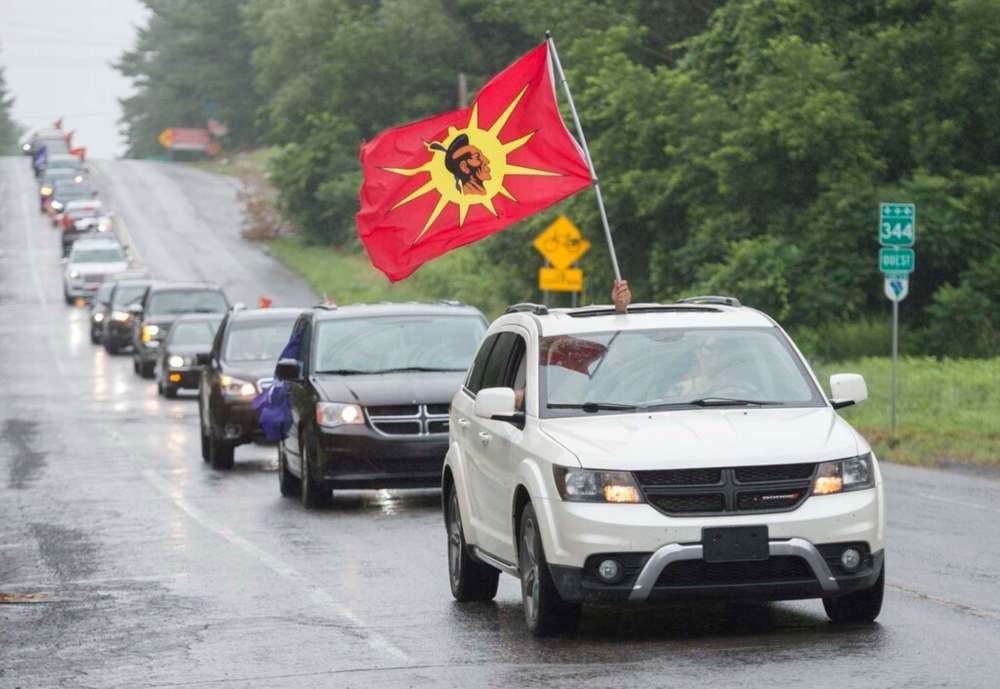Standoff spurred land rights reckoning
Thirty years after Oka, Canada continues to promise change but rarely delivers
Advertisement
Read this article for free:
or
Already have an account? Log in here »
To continue reading, please subscribe:
Monthly Digital Subscription
$19 $0 for the first 4 weeks*
- Enjoy unlimited reading on winnipegfreepress.com
- Read the E-Edition, our digital replica newspaper
- Access News Break, our award-winning app
- Play interactive puzzles
*No charge for 4 weeks then billed as $19 every four weeks (new subscribers and qualified returning subscribers only). Cancel anytime.
Read unlimited articles for free today:
or
Already have an account? Log in here »
Hey there, time traveller!
This article was published 13/07/2020 (1376 days ago), so information in it may no longer be current.
Thirty years ago, armed La Sûreté du Québec officers besieged a barricade occupied by peaceful Kanien’keha:ka (often called Mohawks) of Kanesatake.
At the blockade in the early hours of July 11, 1990, were warriors, elders, women, and children who had come together to block the Quebec town of Oka’s plans to expand a golf course and build condos on their ancestral lands.
“The Pines,” as community members called it, were lands their nation had never ceded; territories where relations were buried, medicines were picked, and ceremonies performed.

On the morning of the attack, the community was holding a smudge ceremony and had received assurances authorities wouldn’t interfere until it was finished.
Seizing the opportunity, La Sûreté used tear gas and then fired bullets into the community. Warriors fired back and the police quickly retreated, even leaving their vehicles behind — which were symbolically added to the blockade.
When the dust settled, one officer was shot (and later died) and a 78-day standoff began which came to be known as the Oka Crisis. Eventually, the federal government would send in tanks and 2,500 troops from the Canadian military (costing taxpayers over $200 million).
On Sept. 26, 1990, the “crisis” came to an end in a stalemate, with promises by the federal government to never again let land disputes become so conflictual. (Spoiler alert: it failed.)
Still, the Oka Crisis was not a crisis. It was standoff, yes; but of Indigenous peoples peacefully protecting their homes and lives.
If anything was a crisis, it was Canada’s realization it couldn’t just steal Indigenous lands without consent and consequence. Up to this point, laws such as the Indian Act made the theft of Indigenous lands “legal,” and resistance “illegal.”
While treaty and Aboriginal rights had been guaranteed in section 35 of Canada’s constitution, Canada simply ignored discussions around these rights, and the Supreme Court hadn’t faced many challenges to define them yet.
As Elijah Harper demonstrated a few months earlier in his protest against the Meech Lake Accord, 1990 was a reckoning that began a 30-year journey into today.
Throughout the summer of 1990, Indigenous-led solidarity blockades and unity camps sprung up across the country.
In Manitoba, this took the shape of the “Peace Village” on the front lawn of the legislature.
Organized by the Assembly of Manitoba Chiefs and the Original Women’s Network, the camp was meant to be in solidarity with the Kanien’keha:ka, but soon fostered a litany of Manitoba-centred land and rights issues surrounding Hydro, residential schools, child welfare, and the over-incarceration of Indigenous peoples.
The village grew quickly: by Sept. 12, there were a medicine lodge, a headquarters, and 39 tents and three teepees. Elders from all First Nations and Métis communities in Manitoba circulated throughout the site, and four coloured banners were flown over the camp, embodying “the four nations of people.”
For days, the camp grew, attracting viewers with speakers such as AMC grand chief Phil Fontaine and entertainment by dancers and singers. People brought lawn chairs or stayed for days.
By Sept. 14, there were 60 tents and 200 people sleeping on the grounds of the legislature.
This is where I come in, as a 14-year-old boy. The Peace Village was where I first learned a history I was never taught in school: Winnipeg’s first modern-day, wide-scale re-occupation of Indigenous territory.
The events of 1990 produced some major outcomes.
The Royal Commission on Aboriginal Peoples was established a year later. It is the largest examination of Indigenous experiences in Canadian history, and offered 440 recommendations to rebuild relationships with Indigenous nations and recognize Indigenous rights — something we might call “reconciliation” today.
While almost none of these recommendations have been implemented, it set the groundwork for the Truth and Reconciliation Commission of Canada and the National Inquiry into Missing and Murdered Indigenous Women and Girls.
The events of 1990 also set Canada on a more inclusive constitutional path for Indigenous peoples that would become the 1992 Charlottetown Accord. It would fail in a national referendum, but not without proving Indigenous nations must be at any future negotiating table.
The events of 1990 also produced people like myself, and taught us to be proud of who we were and to never allow others to dominate and define us.
Unfortunately, Canada didn’t learn as much and has been stuck in a cycle ever since: conflict, commission, and promises for change that almost never get delivered. From Ipperwash to Elsipogtog to the Wet’suwet’en, this is Canada’s formula for continuing to try and take the land.
At the same time, Indigenous resistance continues to grow, too. Thirty years ago, the Kanien’keha:ka started a movement we are still moving in today. Miigwech.
niigaan.sinclair@freepress.mb.ca

Niigaan Sinclair
Columnist
Niigaan Sinclair is Anishinaabe and is a columnist at the Winnipeg Free Press.


